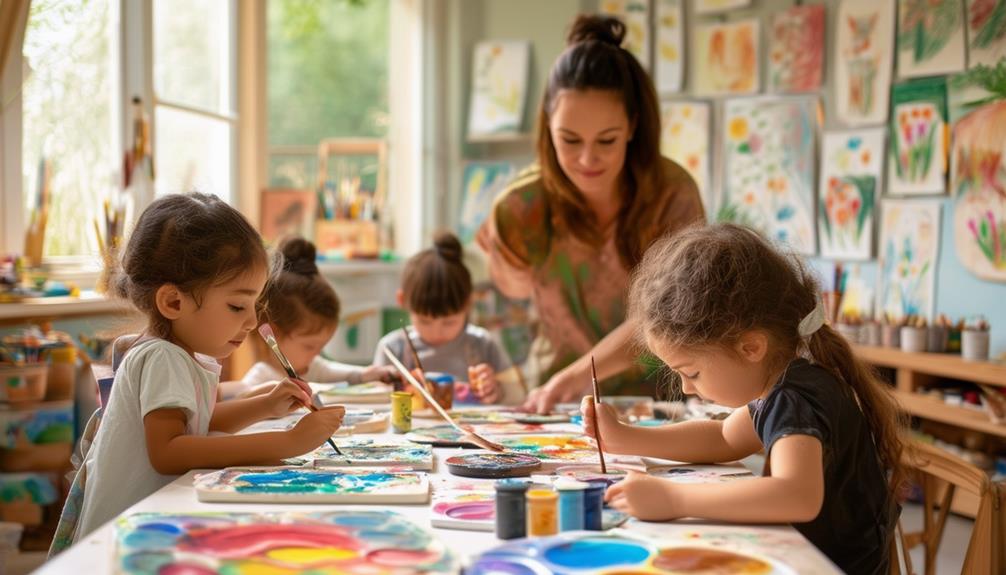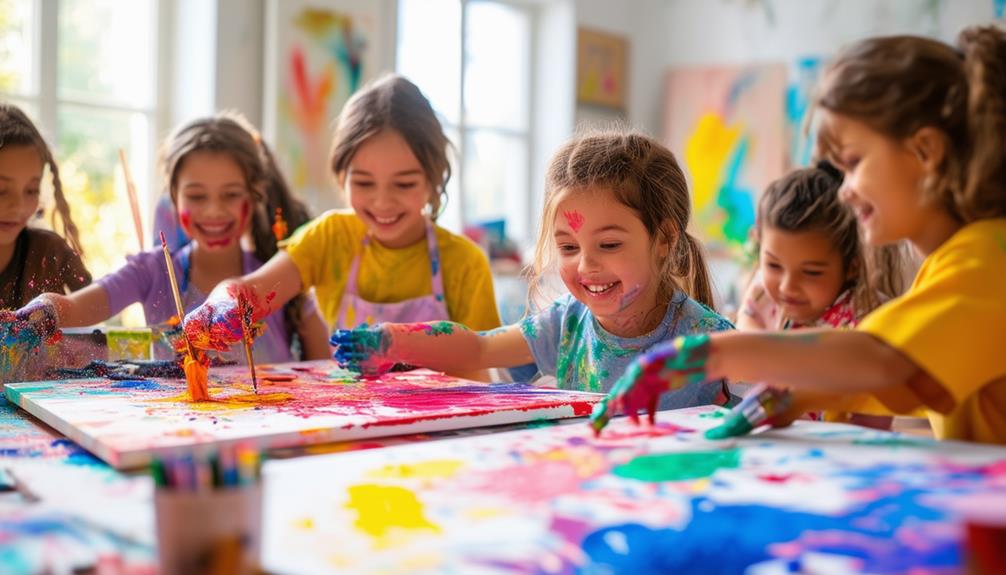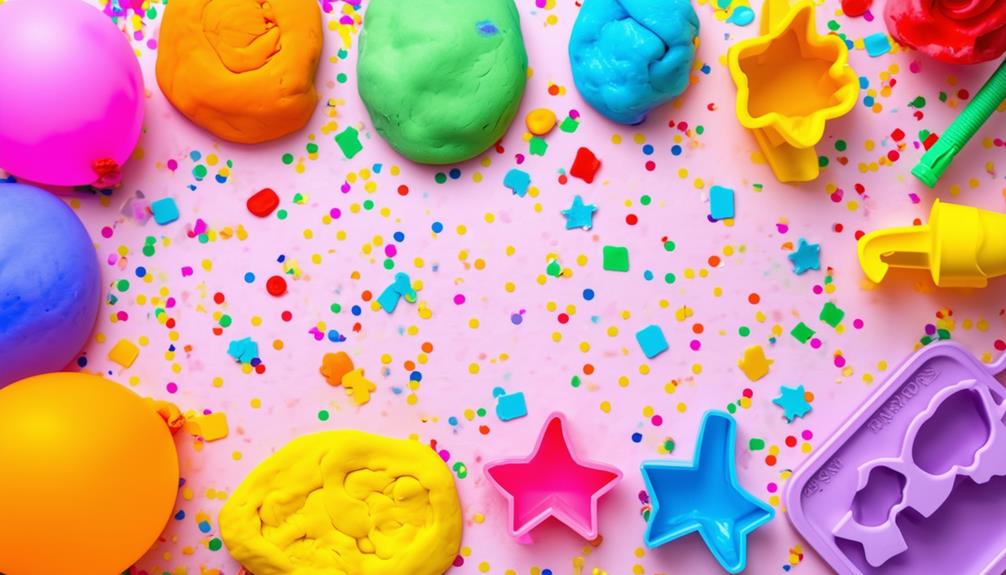Playdough and Math: Educational Activities for Early Learners
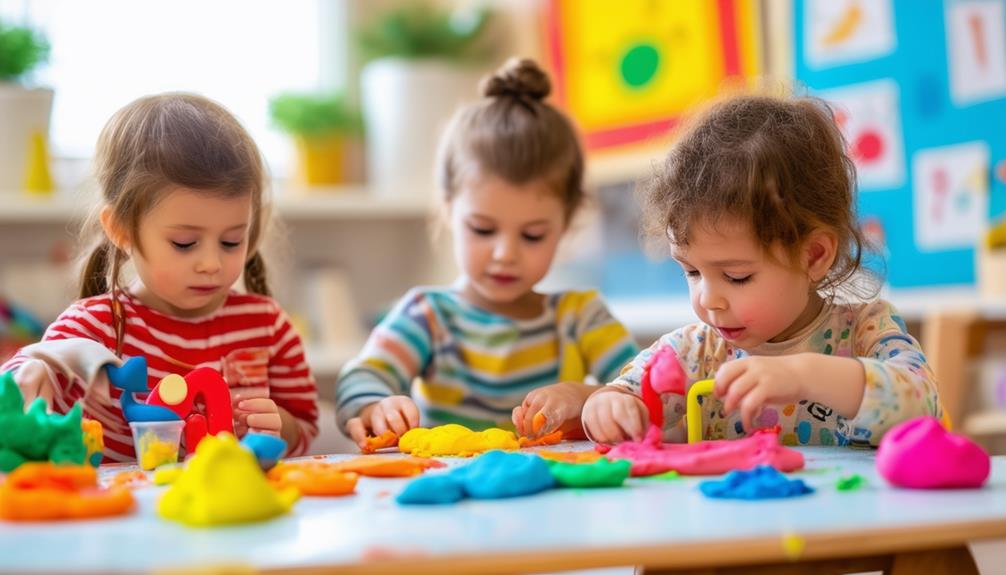
Playdough might seem like just a messy toy, but it's actually a powerful educational tool for teaching math to early learners. Incorporating playdough into math activities helps children grasp complex concepts like number recognition and geometric shapes in a hands-on way. By sculpting numbers or forming shapes, kids not only learn math but also enhance their fine motor skills. Curious about how this works and the added benefits? Let's explore how simple playdough activities can make math both fun and educational.
Benefits of Playdough
How can playdough, a simple childhood favorite, provide significant benefits for early learning? While you might initially think of playdough as merely a fun, squishy toy, it offers much more. Playdough enhances fine motor skills, which are crucial for tasks such as writing and cutting. When children squeeze, roll, and shape the dough, they strengthen the small muscles in their hands and fingers, preparing them for more intricate tasks in the future.
Sensory exploration is another major benefit of playdough. The tactile experience of manipulating playdough stimulates both touch and sight, aiding in focus and information retention. This sensory engagement is essential for cognitive development, making learning a more holistic experience.
Incorporating playdough into math activities can make abstract concepts tangible and engaging. For instance, playdough can be used to create shapes, count pieces, or solve simple addition and subtraction problems. This hands-on approach transforms math into a fun, interactive experience, helping children more easily grasp basic concepts.
Playdough and Fine Motor Skills
Playing with playdough significantly enhances young children's fine motor skills through activities like squeezing, rolling, and shaping. These actions are crucial for strengthening hand muscles, which are essential for tasks such as writing and cutting. When children manipulate playdough, they are not just having fun; they are also building hand-eye coordination and dexterity.
As children engage in these activities, they gain better control over their hand movements, directly supporting their early childhood development and preparing them for academic tasks. For example, rolling playdough into snakes or shaping it into various forms helps them develop the precision needed for gripping a pencil or using scissors.
Incorporating playdough into your child's routine provides a hands-on approach to improving fine motor skills. It's a simple and effective way to ensure your child gets the necessary exercise for their developing hands. So, the next time you see your child squeezing and shaping playdough, remember they are not just playing—they are also strengthening essential skills for their future success.
Sensory Play With Playdough
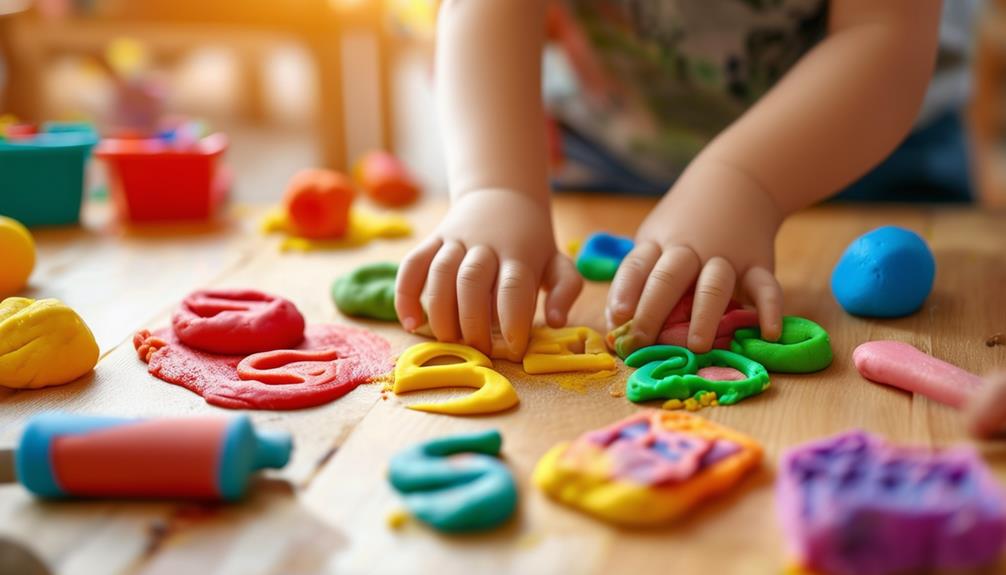
Engaging in sensory play with playdough stimulates your child's tactile and visual senses, enriching their sensory experiences. This activity is not only enjoyable but also crucial for cognitive development. Playdough activities provide a hands-on approach that improves focus and retention, making learning more effective and enjoyable. Adding scented playdough enhances sensory input, making the experience even more immersive.
Here are four excellent sensory activities you can try with playdough:
- Texture Exploration: Encourage your child to press various objects into the playdough to create different textures, enriching tactile learning.
- Color Mixing: Combine different colored playdough to discover new colors, aiding in the understanding of color theory and providing visual stimulation.
- Scented Playdough: Add aromatic oils or food extracts to the playdough. Pleasant scents can make the activity more engaging and calming.
- Shape Making: Use cookie cutters or molds to create different shapes. This activity improves motor skills and introduces basic geometry concepts.
These multi-sensory playdough activities support a holistic approach to learning by engaging multiple senses simultaneously, encouraging your child's exploration and understanding of the world.
Playdough Math Mats
Playdough math mats offer children a hands-on approach to exploring math concepts through engaging activities. These versatile tools can be used for various math-related tasks such as counting, number recognition, and simple calculations. By incorporating playdough, children can manipulate and understand math concepts in a tactile and visual manner, making abstract ideas more concrete and accessible.
Using number mats, children can roll playdough into small balls to match the numbers on the mat. This activity reinforces number recognition and helps develop fine motor skills. Additionally, different math activities can be introduced with these mats, such as creating playdough shapes to match numbers or solving simple math problems.
Here is an overview of how playdough math mats can be utilized:
| Activity | Focus Area | Benefit |
|---|---|---|
| Counting Balls | Number Recognition | Fine Motor Skills |
| Number Matching | Counting | Visual Learning |
| Simple Calculation | Math Operations | Tactile Engagement |
Teaching Shapes With Playdough
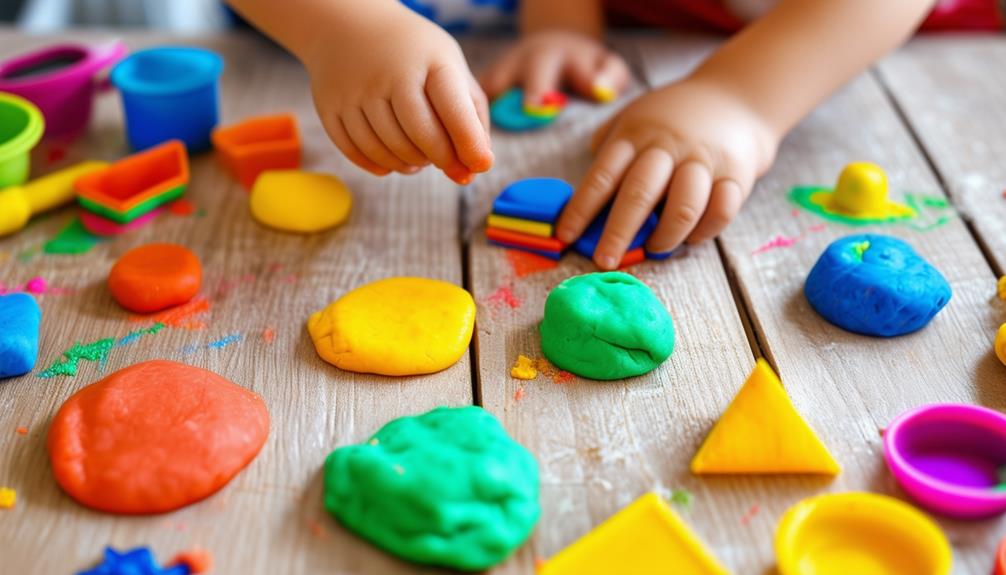
Using playdough to teach shapes enhances spatial awareness and hand-eye coordination. Playdough mats facilitate shape recognition, fostering creativity and aiding in the comprehension of early geometry concepts. These interactive activities engage children and help them effectively visualize and remember shapes.
Shapes Recognition Techniques
Using playdough mats provides children with an engaging, hands-on approach to shape recognition. These mats facilitate a more intuitive and enjoyable exploration of geometric forms. By manipulating playdough into circles, squares, triangles, and other shapes, children can gain a concrete understanding of these concepts.
Here are four key benefits of using playdough mats for teaching shapes:
- Interactive Learning: Children can manipulate playdough to match the shapes outlined on the mats, reinforcing their understanding of various geometric forms.
- Tactile Engagement: The physical act of shaping playdough helps develop fine motor skills and improves hand-eye coordination.
- Creativity Boost: Kids can experiment with different shapes, enhancing their imagination while learning fundamental geometry concepts.
- Visual and Kinesthetic Learning: Playdough mats cater to visual and kinesthetic learners by providing a tangible way to see and feel the shapes they are learning about.
Using playdough for shape recognition not only makes learning enjoyable but also helps children visualize and understand geometric shapes in a concrete and interactive manner. This method fosters a deeper comprehension of shapes, laying a strong foundation for future mathematical learning.
Spatial Awareness Development
Engaging children in playdough activities significantly enhances their spatial awareness and shape recognition. By incorporating playdough mats into learning, kids can both visually and tactilely explore various shapes. This hands-on approach not only helps them recognize and differentiate between shapes but also strengthens their spatial reasoning skills.
Playdough mats offer a structured yet adaptable method to introduce early geometry concepts. These mats typically feature shape outlines that children can fill with playdough, reinforcing their understanding through repetition and practice. By interacting with these mats, children learn to identify shapes and grasp the relationships between different shapes and their dimensions.
Here's a concise table to illustrate the benefits:
| Benefit | Description |
|---|---|
| Shape Recognition | Identifying and naming diverse shapes. |
| Spatial Awareness | Understanding the space and positioning of shapes. |
| Fine Motor Skills | Developing hand-eye coordination through playdough manipulation. |
| Early Geometry Concepts | Learning basic geometry through visual and tactile methods. |
This approach ensures that children develop a well-rounded understanding of shapes and spatial relationships, laying a strong foundation for future learning in mathematics and related fields.
Creativity and Coordination
Teaching shapes using playdough mats not only enhances children's creativity but also boosts their coordination skills. When kids press, roll, and mold playdough into various shapes, they engage in activities that enhance spatial awareness and hand-eye coordination. These interactive activities make learning enjoyable, helping children grasp early geometry concepts more effectively.
Using playdough mats for shape recognition is an excellent way to support the development of fine motor skills. Manipulating playdough strengthens the small muscles in their hands and fingers, essential for tasks such as writing and buttoning clothes.
Here's how to use playdough mats to teach shapes effectively:
- Shape Identification: Encourage your child to identify and name each shape on the mat.
- Shape Creation: Have them form the shapes using playdough, matching them to the outlines on the mat.
- Shape Tracing: Let them trace the shapes with their fingers or playdough tools to improve precision.
- Shape Sorting: Mix up different shapes and ask your child to sort them according to the mat.
Incorporating playdough into shape-learning activities makes abstract math concepts tangible and easier for children to understand, fostering both creativity and coordination.
Counting With Playdough
Using playdough for counting activities engages children in tactile learning, reinforcing their understanding of numbers through hands-on practice. They can form numbers with the playdough, enhancing visual recognition in an interactive and enjoyable way. This multi-sensory approach ensures that learning math is both effective and fun for young learners.
Tactile Counting Practices
Using playdough for tactile counting practices allows children to engage their senses while enhancing fine motor skills. Play Dough Mats serve as excellent guides for these activities. By pressing playdough into numbered spaces on the mats, kids can build their fine motor muscles. Here's how to make counting both fun and educational:
- Shape Numbers: Have children roll playdough into small balls and place them on numbers outlined on Play Dough Mats. This reinforces number recognition and counting skills.
- Create Quantities: Encourage kids to form a specific number of playdough balls or shapes, corresponding to a given number. This helps with one-to-one correspondence and counting accuracy.
- Pattern Play: Using playdough, children can create patterns or sequences that match a number series on their mats. This supports their understanding of number order and relationships.
- Counting Mats: Design mats with spaces for different amounts of playdough objects. Children can count and fill each space, reinforcing the concept of quantity.
These tactile experiences with playdough support counting and number skills, making math concepts tangible and concrete. By engaging their senses and manipulating the playdough, children develop a deeper understanding of early math principles.
Visual Number Recognition
Building on tactile counting practices, you can also use playdough to help kids visually recognize numbers and their corresponding quantities. By forming numbers with their hands, children not only reinforce counting skills but also improve their visual number recognition. Playdough math activities provide a multi-sensory approach to learning, allowing kids to see, touch, and manipulate the numbers.
Start by having the kids roll playdough into thin strands and shape these strands into numerical symbols. As they create each number, encourage them to pair it with the correct number of playdough balls or other small objects. This hands-on method helps children associate numerical symbols with actual quantities, making abstract concepts more tangible and easier to grasp.
Another engaging activity is to use playdough mats with printed numbers. Kids can fill in the outlines with playdough, reinforcing the shape and form of each digit. This not only aids in visual number recognition but also enhances fine motor skills. By incorporating these tactile and visual elements, playdough math activities make learning numbers engaging and memorable. Kids are more likely to retain what they've learned when they're actively involved in the process.
Math Operations With Playdough
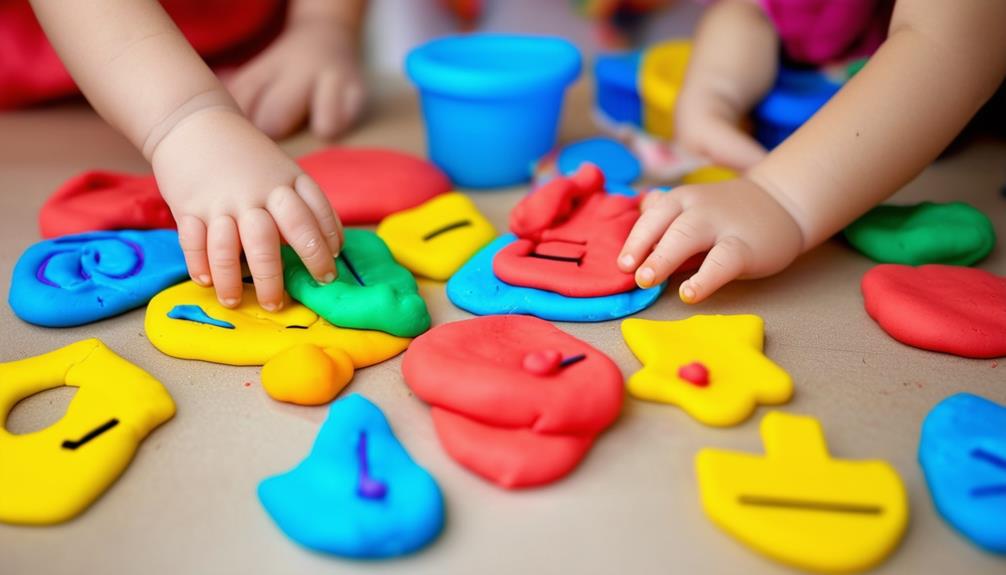
Incorporating playdough into math lessons transforms abstract addition and subtraction concepts into engaging, hands-on activities. By integrating playdough into your math curriculum, you can help children develop a stronger understanding of math operations while also enhancing their fine motor skills.
To get started, here are four playdough activities that make learning math operations fun and interactive:
- Number Sculpting: Have children roll playdough into small balls to represent numbers. This visual and tactile activity solidifies the concept of quantities and numbers.
- Combining Challenge: Ask kids to create two sets of playdough objects and then combine them to see how addition works. This makes the abstract concept of adding numbers tangible.
- Smash Subtraction: Form a number of playdough balls and then smash a few as you subtract. This physical action makes subtraction clear and memorable.
- Math Story Problems: Use playdough to act out story problems. Children can create characters and objects, making the math problems more relatable and easier to understand.
These activities are perfect for guided math centers, promoting interactive learning and helping children build a solid foundation in math skills. Playdough math operations not only make learning enjoyable but also support math fluency.
Social and Emotional Benefits
Engaging with playdough provides children with a unique opportunity to develop vital social and emotional skills. During early childhood, sensory play like working with playdough offers calming effects, aiding in emotion regulation. As children shape, mold, and create with playdough, they engage in soothing activities that help manage stress and frustration.
These activities also promote collaboration, enhancing social skills such as sharing and turn-taking. When children collaborate on projects or share tools, they practice valuable communication and teamwork skills. These interactions help them navigate social situations and build relationships, essential for their future development.
Moreover, creative playdough activities boost children's confidence and self-esteem. They feel a sense of accomplishment as they transform their ideas into tangible creations without fear of judgment. This positive environment fosters creativity and self-expression, crucial for emotional growth.
Homemade Playdough Recipe

Creating your own playdough at home is simple and allows for endless customization to enrich math learning activities. The basic playdough recipe involves common household ingredients and can be tailored to suit your needs. Here's what you'll need:
- 2 cups of flour
- 1 cup of salt
- 2 tablespoons of cream of tartar
- 2 tablespoons of cooking oil
- 1 to 1.5 cups of hot water (adjust as needed)
Mix the flour, salt, and cream of tartar in a bowl. Add the cooking oil and hot water, stirring until the mixture forms a dough. Knead the dough until it's smooth, adding more flour if it's too sticky. For a pop of color, incorporate food coloring during the mixing process.
Using homemade playdough in math activities is not only cost-effective but also safe, providing a hands-on approach to learning. Store your homemade playdough in a well-sealed container, and it can last up to three months, ensuring ongoing sensory play.
Adjusting the consistency is easy; just add more flour if needed. With vibrant colors from food coloring, you can create an engaging and educational experience for early learners, making math fun and interactive.
Quick Playdough Activities
Quick playdough activities such as Lego Counting Fun, the Fruit Pies Activity, and the Building Trees Challenge provide engaging methods to teach math concepts. These hands-on exercises make abstract ideas more tangible and help improve fine motor skills. Each activity transforms math learning into an enjoyable and educational experience.
Lego Counting Fun
Combine Lego bricks and playdough to create a fun, hands-on counting activity that enhances both math skills and fine motor development. This Lego counting activity is ideal for early learners, offering a tactile and visual way to engage with numbers.
Here's how you can get started:
- Create Numbered Playdough Mats: Roll out playdough into flat mats and imprint numbers onto each one.
- Lego Brick Counting: Have your child place the corresponding number of Lego bricks onto each playdough mat, matching the imprinted number.
- Build Towers: Challenge your child to build Lego towers that match the numbers on the mats, reinforcing their understanding of quantity and number recognition.
- Fine Motor Practice: Pressing Lego bricks into the playdough strengthens fine motor skills, making it a dual-purpose activity.
This activity transforms learning into a sensory experience, making math enjoyable and interactive. By using playdough and Lego bricks, you help your child visualize numbers and develop a concrete understanding of counting. Plus, it's a fantastic way to keep their hands busy and their minds engaged. You'll love seeing their excitement as they successfully match numbers and build their counting skills in a playful, hands-on way.
Fruit Pies Activity
Prepare yourself to dive into a fun and educational Fruit Pies Playdough Activity that seamlessly blends counting, numeral recognition, and fine motor skills development. This hands-on math activity invites children to create pretend fruit pies using mini pie tins, rolling pins, and wooden numbers. Not only will your little ones practice counting, but they'll also strengthen their fine motor skills by manipulating playdough to form realistic-looking pies.
Begin by rolling out the playdough and pressing it into mini pie tins. Introduce wooden numbers to enhance numeral recognition. Children can place the correct number of 'fruit' pieces, made from playdough, onto their pies, reinforcing counting and basic addition skills. As they engage in this activity, they'll improve their math fluency and spatial awareness while having a blast!
Here's a breakdown of the activities and their benefits:
| Activity | Skill Developed | Emotional Benefit |
|---|---|---|
| Rolling playdough | Fine motor skills | Satisfaction from control |
| Placing numbers | Numeral recognition | Confidence in math ability |
| Counting 'fruit' | Counting, addition | Joy in learning |
| Filling pie tins | Spatial awareness | Fun in creativity |
This interactive playdough math activity is a creative and sensory-rich way to reinforce early math concepts, ensuring your child learns while playing!
Building Trees Challenge
Immerse yourself in the Building Trees Challenge, where children use playdough and silk leaves to create their own imaginative trees while honing their fine motor skills. This engaging activity seamlessly blends fun and learning, making it an excellent addition to any early education curriculum.
By manipulating dough and arranging leaves, children improve their hand-eye coordination. The tactile experience of the dough helps them explore different shapes, patterns, and sizes, fostering spatial awareness. Additionally, this activity is highly adaptable, allowing for adjustments in complexity to suit various skill levels.
Here's how you can set up the Building Trees Challenge:
- Gather Materials: You'll need playdough in different colors, silk leaves, and a flat surface to work on.
- Create the Trunk and Branches: Have the children roll the dough into shapes to form the trunk and branches of their tree.
- Add Leaves: Encourage them to stick the silk leaves onto the dough branches, arranging them in various patterns.
- Examine Shapes and Sizes: Discuss the shapes and sizes of the branches and leaves, prompting them to think about patterns and symmetry.
This hands-on activity is an excellent way to foster creativity and developmental skills in a fun, interactive environment.

